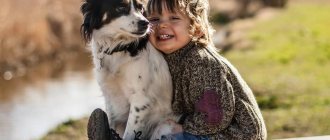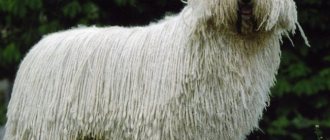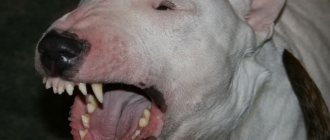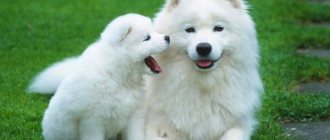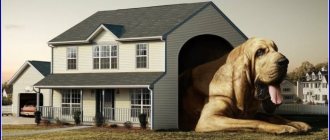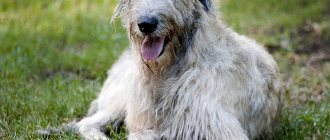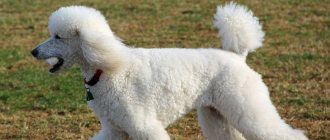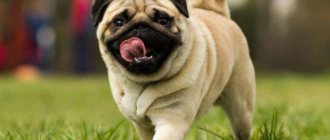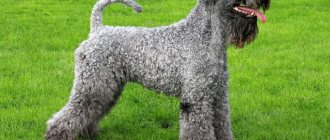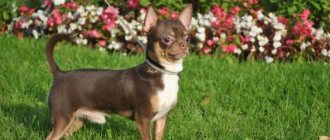What is agility
These are actually sports competitions, during which the animal goes through a certain course with obstacles and equipment. At this time, the dog is led by the owner or handler - the guide. If you try to understand in more detail what this is agility for dogs and the owner, then you must first of all understand that this is a serious physical activity for both. A person needs to constantly be nearby, run or move quickly, in order to give commands to his pet.
Why does a dog need agility?
Shells
Agility competitions in Russia are held in accordance with FCI rules on approved equipment. They must be safe for dogs and comply with certain size rules.
- Barriers.
- Swing.
- Slalom.
- Viaduct (wall).
- Hard tunnel.
- Soft tunnel.
- Tire.
- Slide.
- Long jump.
- Boom.
- Table.
History of the sport
Clicker for dogs: what is it and what is it for?
Agility appeared in the UK back in the 70s. In English it is translated as "dexterity". Initially, this sport was intended as entertainment. Now this is a serious sports discipline for dogs.
The founder is John Varley, who was fond of equestrian sports and decided to entertain spectators at dog shows. As a result, I created something similar to what is present in equestrian sports, when horses go through a course with obstacles.
For the first time, 2 dog teams competed. The audience's delight could not be described. Agility began to be demonstrated more and more often at exhibitions and eventually became a regular competition and was recognized as a sport. Unified rules were developed.
How dogs overcome obstacles
SobakinoAbout dogs for people
One of the important skills required for a dog is overcoming obstacles. Developing this skill not only helps keep the dog in excellent physical shape, but also disciplines him.
Having reached three months of age, the puppy is ready for training. Training must be done daily. Before the lesson, you need to think about the place where it will take place. During the training process, you should always remember about the dog’s safety, which is especially important at the initial stage of training. To execute the command “Barrier!” It is necessary to prepare a dry, non-slip surface for the puppy to avoid injury.
Before training, be sure to prepare your pet’s favorite treat to reward him for successfully following the command. It is not a good idea to force your dog to take on high hurdles right away, as this may be too much for him to handle. You need to increase the height of the obstacle gradually, moving to higher barriers only after the dog can easily take the previous ones. When striving for a specific training result, you need to take into account the breed of the dog. Muscular, powerful, but medium-sized dogs overcome even the highest obstacles much easier than massive and loose ones. Therefore, there is no need to force the St. Bernard to strive for the achievements of the Greyhound.
Dogs use different techniques to overcome obstacles of different heights. So, the dog jumps over a low obstacle with all four paws at once, as if flying over it. And in order to overcome a high blind barrier, the dog runs up, jumps on it, clings with its front paws and only then pulls up its hind paws, after which it jumps down. In the process of learning to overcome obstacles, it is necessary to insure the dog against falls at first.
The puppy should be trained, starting with low, narrow obstacles, 10-15 cm high. It is better if the owner runs with the dog and, as if by chance, overcomes small obstacles with it. Immediately before the jump, you need to clearly say the command: “Barrier!” Even if the puppy has already jumped over the obstacle, it is necessary to give a command even after that. If the puppy does not want to jump, he needs to be directed using a leash. This should not be done aggressively; it is not advisable to try to forcefully drag the dog over the obstacle. This will only cause even greater reluctance on her part and delay the learning process. You need to go around the obstacle, call the dog and pull the leash towards you. It is also worth patting the obstacle with your hand, clearly pronouncing the command.
If the dog knows the command “Fetch!”, you can throw a stick or a favorite object over the barrier. When the dog overcomes the obstacle, he must be praised and treated with his favorite treat. Barrier exercises should be performed 3-4 times per workout. As soon as the dog understands the technique of executing the command, it will be able to overcome the obstacle without the help of its owner.
From 6-8 months of age, a dog that has mastered small obstacles can be trained to overcome high blind barriers. It is necessary to bring the dog to the barrier and, after patting it, give a command. In this case, you need to help the dog grab the obstacle with its front paws and push it slightly. This exercise should be performed 2 times per workout.
A dog sport like agility will help develop your dog’s agility and speed. It represents the fastest possible passage of a track overcoming various obstacles - booms, slides, swings, artificial barriers and tires. Special training areas are equipped with these elements. However, for training you can use anything you can find on the street - fences, benches, stairs, etc. One of the obstacles used in agility is the boom.
This is a beam on racks, along the edges of which a gangway is fixed. It is worth starting classes on a wide flat boom no more than half a meter high with a gentle descent. On a narrow boom, the dog must be supported under the belly, held firmly by the collar, so that it does not fall. Because if this happens, the dog will remember the pain for a long time and will not be able to continue exercising. Each completed exercise should be rewarded with praise from the trainer and a treat.
If the dog is healthy, then climbing stairs will not be a difficult task for him. And when going down the stairs, the owner should be slightly ahead of the dog in order to prevent it from falling if necessary. When the dog comes down, it must be praised. Subsequently, the dog will learn to climb up and down on its own.
In order for a dog to overcome a low obstacle, it needs to be given the command “Crawl!” The dog needs to be put down with a treat at the ready. The trainer's left hand should rest on the dog's withers to prevent it from standing up. The right hand with a tasty morsel for the dog should be extended forward. Having commanded “Crawl!”, you need to push the dog forward. Of course, the dog will try to get up, but the trainer’s hand, lying on the withers, will not allow him to do this. The dog will crawl towards the food. After she achieves her goal, she needs to be praised. You can replace the treat with your favorite toy.
When the dog develops the skill of crawling to the distance of the trainer's outstretched arm, it is necessary to develop crawling over a longer distance. To do this, you need to place the treat 2-3 meters away from the dog. While holding the dog, you should help him crawl to the food, which you need to lift and feed to the dog from your hand.
If the dog does not want to crawl and immediately rolls over onto its back, the trainer can lay it between his legs, preventing it from rolling over, and give the command “Crawl!” In this case, the dog must be held by the collar, pushing it forward. The dog should be praised even for modest attempts to crawl.
A dog can learn any skill that is taught to it. The main thing is not to increase the load at a rapid pace, not to rush the animal, but to gradually and persistently train it, achieving excellent results.
Agility classes
A typical route for passing is a field of 30X30 m. Approximately every 3-6 meters a certain obstacle is installed. Each club has the right to make an individual decision regarding the winner and establish its own course.
Halter for dogs: what is it and what is it for?
The main competition class has several categories:
- "Standard". This is a track with a strip and obstacles of various types. There are 15 barriers for beginners, and from 20 for pros.
- "Snooker". First, the dog jumps on a special projectile, then passes 1 obstacle out of 6 and repeats this 3 times.
- “Jumping” or a track with springboards for jumping; additionally, tunnels and slalom can be added.
- "Jackpot" or "Joker". This is an obstacle course divided into two. In the first part of the competition, the choice of springboards rests with the owner, in the second - with the judge.
- "Relay race". Something like “Standard”, but with the participation of several teams: owner - dog.
Important! The routes for all participants are selected depending on the participant’s training.
Obstacles for dogs
Obstacles are divided into two types:
- contact;
- contactless.
The first, as the name implies, the dog can touch, the second - not.
Contact obstacles for dogs include:
- “Boom” is a structure made of boards in the form of a bridge, the width of which does not exceed 30 cm, the inclined parts are equipped with transverse strips, and the permissible contact area is painted in a bright color. When the “boom” occurs, the pet is supposed to run, not jump.
- A “slide” is an obstacle, also made of boards connected at the ends, and its shape resembles an isosceles triangle. The top is 3 m above the ground, the contact zone is right there. The animal also needs to run up the “hill”, not jump, and touch the contact zone with its paw.
- "Pipe", i.e. a hollow structure inside with varying degrees of curvature. The dog can either run or crawl in it.
- A “swing” is a wooden plank about 3 m long, installed on a solid base. The dog runs up onto it, waits for the other end of the swing to go down, and then descends to the ground. On the entry and exit sides of this obstacle there are contact zones that the pet must touch.
- “Tunnel” is a corridor made of thick fabric, inside which the pet runs towards the handler’s voice, blindly. He cannot stop inside such an obstacle.
- "Transition", i.e. a platform equipped with slopes, two of which have contact areas. The animal, following the voice instructions, must ascend and descend according to them.
Non-contact obstacles for dogs include:
- Jumping is an obstacle that the dog must jump over without touching it. A crossbar is attached to a pair of planks, and such structures are installed at a distance from each other. This is called a double or triple jump.
- A fence is an obstacle that also needs to be jumped over, but it does not consist of a crossbar, but of shields or a “hedge”.
- A tire is a circular barrier of rubber (sometimes actually a car tire) wrapped in tape or plastic. The dog needs to jump through it without touching it.
- Long jump. To do this, use a series of low platforms that are tightly placed next to each other, or a moat with water. Their pet must jump over without touching their paws.
Types of obstacles in agility
Show ring for dogs: what is it and what is it for?
There are 2 main types of obstacles for dogs in competitions: contact and non-contact.
Contact obstacles
From the name it is clear that in this case direct contact between the projectile and the animal is assumed. The classification of obstacles is as follows:
- "Slide". These are two shields that are connected at a certain angle at the top. the projectile is installed 1.5 meters above ground level.
- "Swing". Something like a board that rotates around its own base.
- "Boom". This is a type of slide with several inclined surfaces and a horizontal board.
- "Tunnel". This is a short, barrel-shaped tunnel. Can be straight or winding.
At each obstacle, the handler gives a specific command to the dog, which is characteristic exclusively of a specific projectile, for example, on the “Swing” - the command “Kach”.
The dog must always watch the owner in order to hear his commands
Jumping obstacles
Non-contact or jumping (running) obstacles require that the participant must overcome them in length or height. Classification:
- “Barrier” – transverse rods mounted on vertical posts.
- “Ring” is a round-shaped projectile.
- “Jump” – several platforms on which the pet jumps.
- “Double barrier” – special bars arranged in parallel.
- A “barrier fence” is a solid wall with an overlay located at the top that can be easily knocked down.
There are a number of other obstacles: “Podium Square”, “Slalom” and others. Each obstacle course for dogs involves the use of a specific command that the dog must follow.
Agility: dog breeds for competitions
any breed of dog can take part in agility . However, based on the practice of previous competitions, it is possible to compile a kind of “top” of dogs most suitable for overcoming obstacle courses. These include: Border Collie, Sheltie, Welsh Corgi, Jack Russell Terriers, Golden Terriers, Australian, German and Belgian Shepherds, English Sprinter Spaniels. By the way, the best results are achieved by dogs of herding breeds.
What dogs can participate in competitions?
There are no restrictions. But not all pets are able to overcome obstacles well. Herding breeds are considered the best in agility.
Depending on height, the following classification is distinguished:
- "S", participants, with a size of at least 35 cm at the withers;
- “M” - from 35 to 43 cm;
- "L" - from 43 cm.
Attention! The main condition of all competitions is that performances begin with the smallest breeds.
Border Collies are considered the best in the “L” category, Shelties are in the second category, and Spitz are among the smallest breeds.
Scoring and types of errors
Each organization has its own rules about what constitutes a failure and whether an attempt can be counted if there were violations. A completed run, which is completed in the minimum time with a minimum of errors, stops, etc., is considered valid. A clean mileage is a mileage without errors.
For different organizations, the following actions may be considered errors:
- Time error: using more time for a run than the standard time of the lane.
- Loss of contact: the dog did not touch the contact zone with its paw while performing an obstacle with the contact zone.
- Knocked Bar: The dog moves or drops the bar while performing a jump.
- Slalom fault: entering between posts on the wrong side (the dog must start at the first post on its left), skipping a post, or moving backwards in an attempt to pass missed posts.
- Going off route: an error in the sequence of passing obstacles.
- Refusal: the dog approached the correct obstacle, but hesitated for a long time or refused to complete it.
- Pass: the dog ran past the obstacle.
- Handler error: The handler intentionally - or in some cases accidentally - touched the dog or obstacle.
- Repeat Obstacle: The handler directs the dog to repeat an obstacle it has already completed when the rules do not allow it. The penalty for this is set by the organization: the athlete may be forgiven, the team may be deducted points but allowed to continue, the athlete and dog may be allowed to finish their run but will be given the maximum obstacle course time for the duration, and so on. Some organizations have no penalty for repeating an obstacle.
- Other errors: the dog bit the judge or handler, the dog or handler exhibited unsportsmanlike behavior, the dog ran away from the ring, the athlete used toys or treats in the ring, the dog ran with a collar (in organizations that prohibit collars during racing), and so on.
Competition rules
Before taking part in the competition, the owner is given a drawing with an obstacle course for familiarization. The handler must remember the scheme and choose the optimal path of movement.
Then the judge talks with all participants and explains the rules and reminds the control time. After the preparatory stage, the judge gives the command and the competition begins.
Important! The owner has no right to touch his pet with his hand; he is allowed to lead the dog only with the help of commands.
Dog training
You can start practicing agility when your dog is four months old. Of course, you can also train with an older dog. Everyone has a chance to win a prize in competitions.
With a young dog, you can immediately begin to study agility equipment and practice for a year, after which it will be clear whether the dog is a future champion.
Agility training can start in a different way. This method is well suited for adult dogs - first take a general obedience course and UGS (controlled city dog), and then get acquainted with agility equipment. A trained dog will only need a month to master them.
Why can a dog be removed from the race?
Removal of a team from a race is possible for the following reasons:
- rough treatment of the pet by the owner;
- disrespectful attitude towards the judge;
- omission or violation of the sequence of use of projectiles;
- several refusals to pass obstacles.
The reason for exclusion from agility can be the presence of any objects in the hands of the owner - this is strictly prohibited. Before the start, the judge explains in detail to the participants their rights and obligations.
Breeds
Every dog will be glad to know what agility is. Any breed of dog, and even mongrel dogs, can take part in the competition. Absolutely any dog can win a prize, because the main thing is a good connection between the owner and the pet, which allows them to work harmoniously as a team.
Dogs with substantial dimensions (Great Danes, Wolfhounds, Leonbergers) may have problems passing some obstacles, for example, it may be difficult for them to squeeze into a tunnel. It will also be more difficult for dogs whose shoulder and hip joints are located at right angles. For this reason, terriers and schnauzers will perform slightly worse in slalom and hurdles, but dogs with a creeping gait, such as shepherd dogs, will have an advantage in these apparatuses.
Nevertheless, absolutely everyone can do agility. After all, cups and victories are not the main thing. First of all, agility training is a great chance to improve your relationship with your pet, strengthen the owner-dog bond and just have fun with your four-legged friend. In addition, it is no secret that a dog must constantly develop. Agility training can be both good physical exercise and food for the mind.
How to start agility training
If you decide to train your dog agility, then you need to start by mastering the basic commands. For these purposes, specialized cynological schools are suitable, where there are areas for practicing this sport.
Agility allows the dog to lead an active lifestyle
Group work will allow the dog to learn not to be distracted by extraneous sounds and other dogs. Under no circumstances should you hit or shout at a dog if it does not want to overcome a certain obstacle.
Advice! It is necessary to praise your pet and try to turn training into an interesting game.
How to teach a dog agility?
The first training can be done at home. Then it is important to train outside. Regularity and consistency are important in this matter. How to train a dog agility? Start with the basics - regular dog training. Make sure she is willing to run alongside you even when you are not holding her on a leash. She should be able to run left or right - at your command. It is important that the pet understands and follows the commands “sit”, “lie down”, “stand”, “come to me”, “forward”. After teaching your dog these commands, it makes sense to move on to training on apparatus. Use treats and praise as incentives at first. Over time, remove the first and leave only the second.
Where can you learn agility in Russia
In the capital of our country there are several kennel clubs where they can teach dogs agility:
- Sokolniki;
- Yasenevo;
- Rublevka.
There are several more clubs in Russia, in Samara, Perm, Rostov-on-Don, Kazan and other cities.
Agility, first of all, is teamwork between the dog and the owner. Both learn understanding and how to rely on each other. Classes allow you to develop dexterity and flexibility in your animal, and keep it in good physical shape. And the owner could use physical activity to maintain health.
Benefits of agility for dogs
A fun outdoor adventure and the opportunity to better understand each other is an important part for a pet. Spending time together and interacting at gaze levels will help the dog better understand its beloved owner. During agility training, the owner and the dog become one team, and if the pet manages to guess which projectile will be next, then the dog is completely delighted.
Physical activity on all types of muscles of the animal provides an outlet for the energy accumulated during the day. An hour-long workout with jumping and fast running replaces a 7-kilometer run. After training, the pet gets tired not only physically, but also mentally. It is very important for a dog to find something to do, because lying on the sofa is not typical for a predator.
During the lesson, the dog is happy and in a good mood, because agility is an exciting game for him. The pet's obedience and understanding of the owner becomes better, and the motivation to guess the owner's wishes remains for the entire time.
Agility is a team sport between the handler or handler and his dog. The handler controls the dog on the site with his voice and gestures. The projectiles are marked with numbers and the handler sends the dog to the correct projectile. While moving around the area, the handler must calculate a short trajectory and let the dog know which projectile will be next to overcome. The fastest dog takes first place.
The correct passage of the projectile and the accuracy of execution are also taken into account in competitions. It is not allowed to give treats or touch the dog on the playground. The collar and leash should also remain outside the ring.
